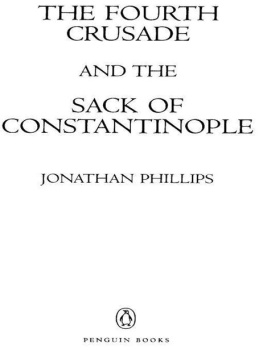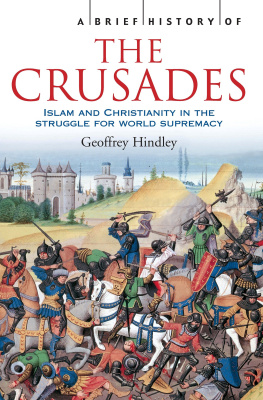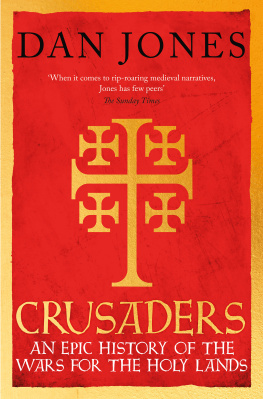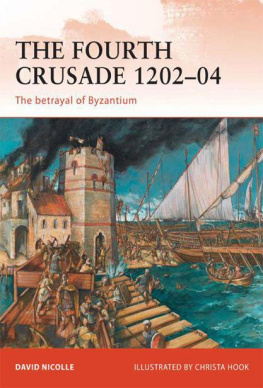Table of Contents
Praise for
The Fourth Crusade and the Sack of Constantinople
In this authoritative and vivid account [Phillips] uses monastic chroniclers, letters, and even the songs of troubadours to reconstruct the brutal sacking of the Byzantine capital and its underlying causes.... A first rate narrative of this significant episode in medieval history.
Publishers Weekly
Timely ... [A] Well crafted tale of brutality and determination, depravity and avarice, political intrigue and religious zealand worse.
Kirkus Reviews
Compelling ... The achievement of Jonathan Phillips is to show ... with a novelists eye, how the flowers of Western chivalry were drawn into infidelity to their ideal. They were seduced, little by little and the femme fatale was the maritime power of Venice.... [Phillips] is admirably reluctant to reduce the astonishing culture clashes of the Middle Ages to the undigested ideologies of the present day.
The Daily Telegraph
Rich testimony ... [A] good read ... The first, very considerable merit of [The Fourth Crusade] is that Phillips, while fully aware of modern perspectives, presents the story to us from the point of view, principally, of the Crusaders themselves ... vivid and memorable.
The Times Literary Supplement
Enthralling ... [an] admirable example of narrative history written with the general reader in mind. Nobody can read [this] without acquiring a better understanding of the Middle Ages and the medieval mind.
Allan Massie, Literary Review
ABOUT THE AUTHOR
Jonathan Phillips is a Reader in Medieval History at Royal Holloway, University of London. He is the author of Defenders of the Holy Land: Relations Between the Latin East and the West, 11191187 (1996) and The Crusades, 10951197 (2002). Phillipss articles have appeared in BBC History, History Today, and the Independent. He is a frequent guest on Radio 4 and BBC World Service as well as Englands Channel 4, the BBC, The History Channel, and PBS. Phillips lives in Windsor, England.
For Tom
and for my parents
PENGUIN BOOKS
Published by the Penguin Group
Penguin Group (USA) Inc., 375 Hudson Street, New York, New York 10014, U.S.A.
Penguin Group (Canada), 90 Eglinton Avenue East, Suite 700, Toronto,
Ontario, Canada M4P 2Y3 (a division of Pearson Penguin Canada Inc.)
Penguin Books Ltd, 80 Strand, London WC2R ORL, England
Penguin Ireland, 25 St Stephens Green, Dublin 2, Ireland (a division of Penguin Books Ltd)
Penguin Group (Australia), 250 Camberwell Road, Camberwell,
Victoria 3124, Australia (a division of Pearson Australia Group Pty Ltd)
Penguin Books India Pvt Ltd, 11 Community Centre, Panchsheel Park, New Delhi110 017, India
Penguin Group (NZ), cnr Airborne and Rosedale Roads,
Albany, Auckland 1310, New Zealand (a division of Pearson New Zealand Ltd)
Penguin Books (South Africa) (Pty) Ltd, 24 Sturdee Avenue,
Rosebank, Johannesburg 2196, South Africa
Penguin Books Ltd, Registered Offices: 80 Strand, London WC2R ORL, England
Copyright Jonathan Phillips, 2004
All rights reserved
Maps drawn by Reginald Piggot
Includes bibliographical references and index.
eISBN : 978-1-101-12626-4
1. CrusadesFourth, 12021204.
2. Istanbul (Turkey)HistorySiege, 12031204. I. Title.
D164.P.503dc22
2004042017
The scanning, uploading and distribution of this book via the Internet or via any other
means without the permission of the publisher is illegal and punishable by law. Please purchase
only authorized electronic editions, and do not participate in or encourage electronic piracy
of copyrighted materials. Your support of the authors rights is appreciated.
http://us.penguingroup.com
Acknowledgements
I N THE COURSE of writing this book I have been fortunate to receive the assistance of a great number of people. During my research I benefited from the generous hospitality and knowledge of Dr Christoph Maier in Basel and Professor Isin Demirkent and Dr Ebru Altan in Istanbul, and the organisational help of Fusun Ersak and Claire Lillywhite-Pinch. Discussions with Matthew Bennett, Dr Linda Ross, Dr Merav Mack, Natasha Hodgson, Dr Marcus Bull, Neil Blackburn, Dr Penny Cole and Professor Jonathan Riley-Smith proved important in formulating my ideas and tracking down various elusive references. Dr Thomas Asbridge has offered sound and cheerful advice from the start of this project. Dr Jonathan Harris, Edwin Fuller and Dr Christoph Maier read all, or part, of the manuscript and their observations and corrections have been invaluable. Any mistakes that remain are, of course, my own. I am grateful to Dr Emmett Sullivan for his skill in producing some of the photographs used here. Sally Tornow, Caroline Campbell, Suzanne Tarlin and David Watkinson, along with Austen and Janice Rose, Dr Ian and Diane Jenkins, Andy and Jackie Griffiths, and Lisa and John Barry, have all provided much encouragement and an important counterbalance to academic life. I am very pleased to acknowledge the perceptive guidance and constant support of my agent, Catherine Clarke, the efforts of her US counterpart, Emma Parry, and the good faith of Wendy Wolf at Viking Penguin. Will Sulkin, my editor at Jonathan Cape, has been enormously helpful, patient and constructive during the writing of this book; the work of Jrg Hensgen, Chloe Johnson-Hill, Ros Porter, Hilary Redmon and Mandy Greenfield was also invaluable. My greatest debt is to Niki for her wholehearted love and commitment to our special life together. I am very happy to dedicate this book to my dear parents and to my wonderful son, Tom.
A Note on Nomenclature
T HE MAJORITY OF the crusading army that set out from Venice in October 1202 originated from areas within France. It included men from Blois, Champagne, Amiens, Saint-Pol, the le-de-France and Burgundy. However, several other regions of Europe sent substantial contingents as well. For example, the count of Flanders, who was subject to the overlordship of the king of France, commanded a large force. Similarly, the leader of the crusade, Marquis Boniface of Montferrat, headed men from his northern Italian homelands. Other notable groups came from the German Empire, including the men under Bishop Martin of Pairis and Bishop Conrad of Halberstadt. Given the polyglot nature of this army it is impractical to set out this list every time these crusaders are mentioned. For reasons of style and brevity, therefore, I have used the word French as a blanket term to cover all of the crusaders listed above. If a specific contingent is under discussion, this will be made clear. Large numbers of Venetians also took the cross, but because they formed a distinct group, they are (where appropriate) distinguished from the French crusaders noted above. Simple references to crusaders or westerners can be taken to refer to the army as a whole, both French and Venetian forces alike. The term Franks refers to those who settled in the Holy Land after the First Crusade (10959), and their descendants.
PREFACE
The CrusadesMedieval and Modern
S INCE THIS BOOK was completedin the autumn of 2003events such as the Madrid bombing and the US-led invasion of Iraq have inspired parallels between the medieval crusades and contemporary times. Reviewers and analysts have sought to explain present-day tensions against a context of earlier conflicts between Islam and the West. A recent spate of documentaries and films testifies to a widespread fascination in the history of the crusades and its perceived relevance today.







